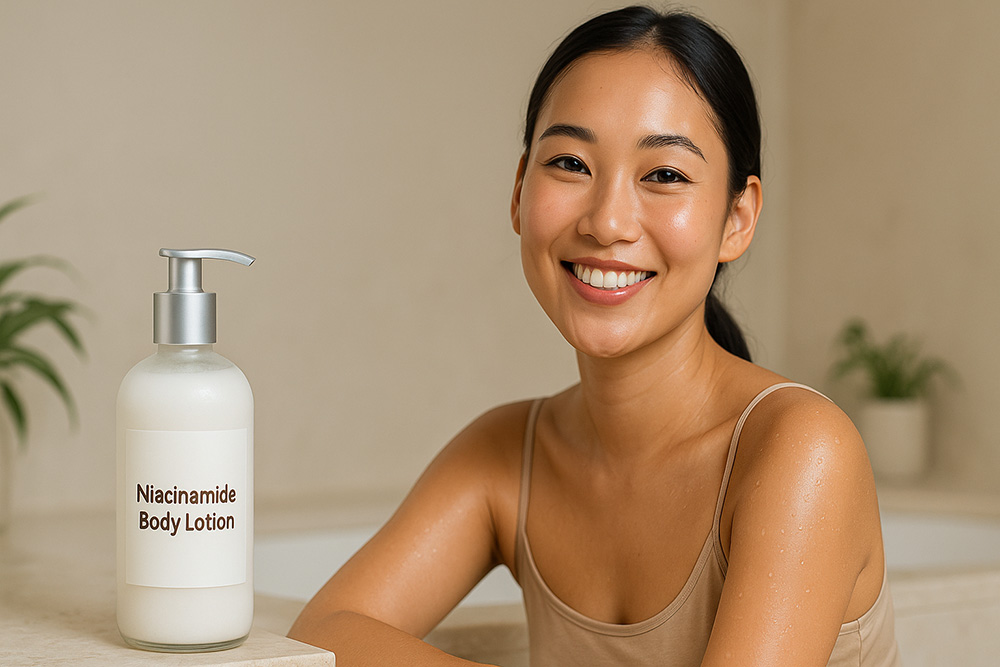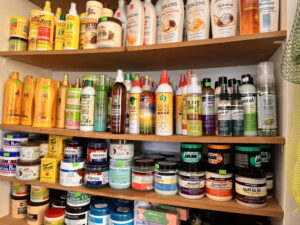Niacinamide Body Lotion:Benefits, Vitamin C Pairing, KP Tips
If you’ve ever wished your body skin could get the same bright, even-toned, calm glow your face gets from a great serum, you’re going to love niacinamide body lotion. This dermatologist-beloved form of vitamin B3 has a rare combo of perks: it’s effective, gentle, and plays nicely with most other ingredients. On the body—where skin is thicker and often drier, itchier, bumpier, or more uneven from sun or friction—niacinamide shines.
This comprehensive guide pulls together peer-reviewed research, dermatologist commentary, and hands-on product know-how to help you choose the right niacinamide body lotion, use it correctly, and tailor it to concerns like “strawberry legs,” keratosis pilaris, uneven tone, body acne, or general dryness. We’ll also address common questions (Is it safe in pregnancy? Can you use 10%? Can you mix the niacinamide powder into your lotion?) and close with SEO-friendly FAQs, titles, and meta descriptions you can use on your site.
Quick take: Topical niacinamide (vitamin B3) helps improve barrier function and hydration, reduces the look of uneven tone and redness, and can help control oiliness—benefits shown across multiple studies and reviews. Expect barrier and texture improvements in ~4 weeks and tone improvements (for hyperpigmentation like melasma or PIH) in ~8 weeks when used consistently.
What is Niacinamide and Why Put It in a Body Lotion?
Niacinamide is the amide form of vitamin B3. In skincare, it’s prized for its barrier-supporting, brightening, soothing, and oil-regulating abilities. Unlike its cousin nicotinic acid (niacin), niacinamide doesn’t cause flushing and is generally well tolerated at typical topical levels.
On the body, you get all the usual face benefits—stronger barrier, smoother texture, and more even tone—plus practicality: it’s easy to apply as an all-over lotion, and you can comfortably use higher strengths than you might on the face if your skin tolerates them.
Scientifically, niacinamide has been shown to:
-
Support the skin barrier (think: more resilient corneocyte envelopes, better moisture retention).
-
Even out tone and reduce hyperpigmentation; in one split-face melasma trial, 4% niacinamide brightened as effectively as 4% hydroquinone over eight weeks with fewer side effects.
-
Help regulate sebum and exhibit anti-inflammatory effects, which is relevant to acne-prone areas (e.g., back/chest).
For a deep dive on mechanisms and clinical evidence, see these open-access reviews summarizing barrier, pigment, and oil benefits.
The Benefits of Niacinamide Body Lotion (By Concern)
1) Dryness, Itch, and a Compromised Skin Barrier
Regular use of a niacinamide-containing moisturizer improves barrier function, which translates into better hydration, less transepidermal water loss, and more resilient skin. A 4-week placebo-controlled study found that 3% niacinamide improved structural markers of the skin’s outermost barrier. That supports what many of us feel anecdotally: skin gets softer and less reactive.
2) Uneven Skin Tone & Dark Spots (Including Body PIH and Melasma)
Niacinamide can reduce the look of hyperpigmentation, likely via interference with melanosome transfer from melanocytes to keratinocytes. In an 8-week split-face clinical trial, 4% niacinamide improved melasma severity similarly to 4% hydroquinone (with fewer reports of irritation). On the body—where PIH from friction, insect bites, or acne is common—this gentle route is compelling.
3) Redness & Sensitivity (Including Rosacea-Prone Skin)
Niacinamide-containing moisturizers have shown barrier and redness improvements and reduced reactivity in subjects with rosacea-prone skin, likely due to anti-inflammatory effects and barrier support. While rosacea treatment is individualized, niacinamide is a commonly recommended supportive ingredient.
4) Oiliness & Body Acne (Back/Chest)
In clinical contexts, preparations 2–5% niacinamide can reduce sebum production—useful for oily zones like the upper back or chest—and can complement acne routines without the sting of stronger actives. If you’re acne-prone, layering niacinamide body lotion with a benzoyl peroxide wash or salicylic acid treatment often makes sense.
Who Should Use Niacinamide Body Lotion?
-
Dry, itchy, or “tight” body skin that needs durable hydration and barrier help.
-
Uneven tone on arms, legs, chest, or back (e.g., post-inflammatory dark marks).
-
KP-prone or “strawberry legs” skin that needs soothing support alongside chemical exfoliants.
-
Oily or acne-prone areas of the body where you want a calming, non-stripping active.
-
Sensitive skin that can’t tolerate stronger actives daily; niacinamide is generally gentle.
How to Choose a Niacinamide Body Lotion
Check the % (When Disclosed)
-
2–5% is the sweet spot for everyday barrier and tone support.
-
Up to ~10% is commonly used in body formulas; many people tolerate it well on the body, but if you’re sensitive, start lower and build up. The cosmetic safety literature supports topical niacinamide at typical use levels with good tolerability.
Pro tip: If the % isn’t listed, lean on brand transparency, reviews, and how your skin feels after 2–3 weeks.
Look at the Full Formula
-
Ceramides + niacinamide = a classic, barrier-loving pairing.
-
Hyaluronic acid, glycerin, and shea add humectant/emollient goodness.
-
If texture and KP are a focus, consider a combo formula with lactic acid or salicylic acid plus niacinamide (more on pairing below). Clinical and guideline sources endorse lactic, glycolic, salicylic acid and urea for KP; niacinamide adds soothing/barrier benefits.
Packaging & Texture
Air-tight pumps for family-size lotions are convenient and help keep actives stable. A fast-absorbing, non-sticky base makes daily use realistic.
A Few Well-Known Examples (non-sponsored)
-
Olay Regenerist Hand & Body Lotion with Niacinamide (B3 complex): a drugstore favorite with a silky finish—and yes, it’s niacinamide-forward.
-
The Ordinary Niacinamide 5% Face & Body Serum: a lightweight emulsion that doubles for face and body—nice for “targeted” body areas.
-
Salt & Stone Seaweed & Niacinamide Body Lotion: a chic option pairing niacinamide with seaweed extracts.
-
Naturium Body Care: this line frequently features niacinamide across body SKUs; scan labels for exact % and pairings.
What about CeraVe? Some body formulas (e.g., SA Lotion/Cream) list niacinamide among ingredients; others—like Daily Moisturizing Lotion—focus on ceramides and hyaluronic acid. Always check the product’s current ingredient list.
How to Use Niacinamide Body Lotion (Step by Step)
-
After a shower, pat skin until damp (not dripping).
-
Apply enough lotion (think: a small puddle per limb) to create a thin film—this matters for actives’ contact time.
-
Frequency: once daily is great to start; most can use twice daily on drier areas. Barrier improvements often show within 4 weeks; tone improvements can take 8+ weeks.
-
SPF on exposed areas by day. Niacinamide plays well with sunscreen; sun care is essential if even tone is the goal.
-
Patch test if you’re reactive: inside of the forearm for 24 hours before slathering everywhere. (General best practice for any new active.)
Smart Pairings (and One Caution)
Pair Well With:
-
Ceramides, glycerin, hyaluronic acid → hydration and barrier synergy. (Great for daily body care.)
-
Vitamin C → compatible in modern formulations; the old “they cancel each other out” myth came from conditions (very low pH + heat) not relevant to normal use. If you enjoy layering, you can use both.
-
Lactic/Glycolic/Salicylic Acid → great tag-team for KP or rough texture; consider alternating nights or layering humectants if you’re dry. Evidence supports AHAs/urea/BHA for KP smoothing.
-
Retinoids (e.g., adapalene, retinol body creams) → niacinamide can make retinoid routines feel gentler; introduce gradually.
Use Caution With:
-
DIY mixing into very low-pH acids: At pH ≤5, niacinamide can hydrolyze to nicotinic acid over time (especially with heat), which may increase flushing/irritation. Finished products are formulated to avoid this; the risk is more about ad-hoc mixing.
Can You Mix Niacinamide Powder Into Your Body Lotion?
Yes—carefully. If you’re using something like The Ordinary 100% Niacinamide Powder, follow the brand’s directions: dissolve ¼ scoop into a water-based product whose pH is 5.1–7.0 (avoid low-pH acids and pure oils), and mix per-use (don’t pre-batch big tubs). This helps you customize strength safely. For a 5% target in 100 g lotion, you’d add 5 g of powder.
Many find it easier (and gentler) to start with a ready-made lotion listing niacinamide among the first handful of ingredients. If you do DIY, measure by weight, keep it clean, and patch test.
How Niacinamide Body Lotion Compares to Lactic Acid Body Lotion
They’re complementary, not competitors:
-
Niacinamide body lotion → barrier strengthening, redness-soothing, tone-evening. Gentle for frequent use, good for sensitive or reactive skin types.
-
Lactic acid body lotion (or ammonium lactate 12%) → keratolytic + hydrating, excellent for KP, rough/bumpy texture, and xerosis. Multiple studies and clinical resources support lactic/SA/urea for smoothing rough body skin.
Best of both worlds: Use AHA/urea lotions a few nights per week for texture, and niacinamide lotion daily for barrier + tone.
Safety, Side Effects, and Who Should Be Cautious
-
Tolerability: Cosmetic safety assessments and clinical use support niacinamide’s good tolerability at typical topical strengths; some people may experience transient redness or tingling, especially at higher percentages or if a product is very acidic (less common in finished lotions).
-
Flushing vs. Niacin: Niacinamide (B3 amide) doesn’t cause the classic niacin flush; if you experience flushing, it’s often from other actives or formulation issues (e.g., pH conditions that convert a small amount to nicotinic acid).
-
Pregnancy: Consumer guidance and dermatology sources generally consider topical niacinamide one of the safer actives during pregnancy (especially compared with retinoids). However, direct pregnancy safety data for many skincare actives are limited; talk with your clinician for personalized advice.
-
FDA “Approval”: In the U.S., cosmetics (including body lotions) do not receive FDA pre-market approval (except for color additives). Products must be safe and properly labeled; the FDA can take action if they’re not. Be skeptical of “FDA-approved lotion” claims.
Real-World Product Landscape & What People Say
Roundups and retailer categories show a growing roster of niacinamide body lotions across price points—from drugstore to prestige. You’ll see options spotlighted by editors (Who What Wear, Ipsy) and major retailers (Target, Amazon). Community discussions on Reddit echo a common theme: people like the glow/clarity and how gentle niacinamide feels compared to stronger body actives; some prefer blends (e.g., seaweed + niacinamide, or niacinamide in KP lotions) for multitasking.
Examples you might encounter: Olay Niacinamide Body Lotion, Salt & Stone Seaweed + Niacinamide Body Lotion, Minimalist 5% Niacinamide Body Lotion, The Ordinary Niacinamide 5% Face & Body, Foundation Skincare Niacinamide Lotion, and more. Always check ingredient lists, % (if disclosed), and your skin’s response.
A Body Routine That Makes Sense (Sample Schedules)
Goal: overall hydration & glow / normal–dry skin
-
Morning: Gentle shower → niacinamide body lotion on damp skin → SPF on exposed areas.
-
Night: Repeat lotion or layer a richer balm on extra-dry spots.
Goal: KP/rough bumps
-
3–5 nights/week: AHA/urea body lotion.
-
Other days: niacinamide body lotion to support barrier and reduce redness/PIH.
Goal: body acne (back/chest)
-
In shower: benzoyl peroxide or salicylic acid wash (avoid your best towels).
-
Post-shower: niacinamide body lotion to calm, support barrier, and help with uneven tone over time. (Introduce slowly if using multiple actives.)
How Often Should You Use Niacinamide Moisturizer?
Daily is ideal for most; twice daily on stubborn dry patches or if you’re targeting tone. Expect barrier feel improvements in ~4 weeks and noticeable tone changes in 8–12 weeks with consistent use, sunscreen by day, and patience.
Ingredient Matchmaking: What Not to Pair With Niacinamide?
Contrary to persistent myths, vitamin C and niacinamide can be used together without neutralizing each other in normal conditions. Reserve caution for DIY mixing with very low-pH acids (strong AHA toners) or raw powders—finished products handle stability; kitchen chemistry often doesn’t.
What Results Can You Realistically Expect?
-
Short term (2–4 weeks): skin feels softer, holds moisture better; irritation from other routines may feel diminished.
-
Medium term (8–12 weeks): gradual brightening of stubborn marks and more even tone on arms, legs, chest, and back. Results vary with sunscreen use and cause of discoloration.
-
Ongoing: better resilience to dry seasons, hot showers, and friction (e.g., waistbands, sports gear).
Try Xiangxiang Daily Now!
We Help You Launch New Products, And Continue To Grow. Try Us With 20% Off Your First Order!
Special Topics People Ask About
Is Niacinamide Good for Rosacea?
As part of a gentle routine, yes—niacinamide moisturizers have shown barrier and redness improvements in rosacea-prone skin. It’s not a prescription treatment, but it’s a supportive, well-tolerated ingredient many dermatologists recommend.
Is Too Much Niacinamide Bad for Skin?
Higher concentrations can increase the chance of tingling or irritation in some people. Many see great results at 2–5%; body skin often tolerates up to ~10% in well-formulated lotions. If you’re sensitive, start lower, especially if you’re also using acids/retinoids.
Is Niacinamide Safe in Pregnancy?
Topical niacinamide is generally considered pregnancy-safe by consumer and dermatology sources, though direct pregnancy data for many topicals are limited. Always discuss your specific regimen with your prenatal clinician.
Is Niacinamide Body Lotion FDA Approved?
No. In the U.S., cosmetics are FDA-regulated but not FDA-approved (except color additives). That’s normal—look for reputable brands, clear labeling, and sensible claims.
Can I Use 10% Niacinamide on My Body?
Often yes—many people tolerate 10% on body skin. If you’re new or reactive, start with 2–5%, then step up. Patch test first.
Add Authority to Your Article with 5 External, Contextual Links
Sprinkle these into relevant sentences (anchors shown in bold):
Cosmetics aren’t “FDA approved”; they’re FDA regulated, not approved.
Evidence for pigment evening:
Vitamin C pairing myth: niacinamide with vitamin C.
DIY route: The Ordinary 100% Niacinamide Powder directions.
Ingredient overview & uses: DermNet on nicotinamide.
These links enhance E-E-A-T, improve topical authority, and help Google understand your page’s context and credibility.
How This Compares to Popular Retail Picks & Roundups
Editorial lists and retailer categories have highlighted niacinamide as a star body ingredient over the past few seasons. Examples include Olay Regenerist Hand & Body (with Niacinamide), The Ordinary Niacinamide 5% Face & Body, and Salt & Stone Seaweed + Niacinamide alongside blends targeting KP or dullness. Community threads (e.g., r/SkincareAddiction) often echo that niacinamide is a friendly “base” active—one you can keep using while you rotate in treatments like AHAs or salicylic acid.
Pro Tips for Specific Use Cases
Keratosis pilaris: Alternate your AHA/urea lotion (3–5 nights/week) with niacinamide body lotion the other days to smooth bumps and calm background redness.
Post-inflammatory hyperpigmentation on legs/arms: Use niacinamide daily + sun protection; add gentle lactic acid 2–4 nights/week. Expect gradual evening over 8–12 weeks.
Back/chest acne: Pair a BPO or SA wash in the shower with niacinamide lotion afterward. (Avoid layering too many leave-on actives at once.)
Very sensitive skin: Choose fragrance-free, ceramide-rich formulas with 2–4% niacinamide. Patch test first.
Common Mistakes to Avoid
Over-exfoliating when you’re already using acids + retinoids + a physical scrub; let niacinamide handle barrier support on off nights.
DIY pre-batching large lotion jars with powders (contamination + stability risks). Mix per use if you’re DIYing, and mind the pH.
Skipping sunscreen on exposed areas. Brightening is a losing battle without daily SPF.
How to Evaluate “Whitening” Claims & Brightening Expectations
“Whitening” (better framed as brightening or tone evening) usually refers to reducing excess melanin or discoloration. Niacinamide doesn’t bleach—it gradually normalizes pigment transfer and helps even tone with consistent use and sun protection. For stubborn patches, combo routines (e.g., niacinamide + azelaic acid, or dermatology-guided treatments) may be needed.
Bottom Line: Should You Switch Your Daily Body Moisturizer to One with Niacinamide?
If you want smoother, calmer, more even-looking body skin with minimal fuss, a niacinamide body lotion is one of the most user-friendly upgrades you can make. It’s gentle enough for daily use, versatile across skin types, and plays well with actives you might already be using for texture or acne. Pair it with sunscreen on exposed areas and give it 4–12 weeks to show what it can do.
FAQ
Is niacinamide good in body lotion?
Yes. It’s a well-tolerated active that supports barrier function, evens tone, and soothes—ideal for everyday body care.
Is it okay to use niacinamide lotion every day?
Absolutely. Most people do best with daily (even twice-daily) application on dry or uneven areas.
Is niacinamide good for body skin?
Yes. The body often needs barrier support and tone evening—both core strengths of niacinamide.
What are the side effects of niacinamide body lotion?
Usually minimal—possible mild tingling or redness at higher strengths. If irritation occurs, scale back or switch to a lower % formula.
What shouldn’t you pair with niacinamide?
It’s broadly compatible. The main caution is DIY mixing with very low-pH acids (risk of nicotinic-acid formation and flushing). Finished products are typically formulated to avoid this.
Is niacinamide the same as hyaluronic acid?
No. Niacinamide is an active vitamin (B3 amide) with barrier/brightening benefits; hyaluronic acid is a humectant that draws water into skin. They work well together.
Should I use retinol or niacinamide?
They do different jobs and often work best together (niacinamide can make retinoid use feel gentler). Introduce gradually if sensitive.
Which is better, lactic acid or niacinamide body lotion?
Different tools: lactic acid smooths rough texture/KP; niacinamide supports barrier and tone. Many routines use both, alternating days.
Is niacinamide body lotion FDA approved?
No. Cosmetics are FDA-regulated, not FDA-approved (except color additives).
What are the disadvantages of niacinamide?
Potential for mild irritation at high strengths or in low-pH mixes; otherwise, it’s among the more forgiving actives.
Which is better, niacinamide or vitamin C?
They’re complementary—use either or both for broader benefits. The “don’t mix” myth doesn’t apply to normal skincare conditions.
Can I use 10% niacinamide on my body?
Often yes, especially on the body. If you’re new or sensitive, start with 2–5% and build up. Patch test.
Does CeraVe body lotion have niacinamide?
Some do. SA Lotion/Cream include niacinamide; Daily Moisturizing Lotion highlights ceramides and HA (always check the current ingredient list).
How do I mix niacinamide powder with lotion?
Use ¼ scoop of The Ordinary 100% Niacinamide Powder with a water-based product between pH 5.1–7.0; avoid strong acids and oils; mix fresh per use. For 5% in 100 g lotion, add 5 g powder.
Table of Contents
Latest Blog Posts
Check out the latest industry trends and take inspiration from our updated blogs, giving you a fresh insight to help boost your business.




